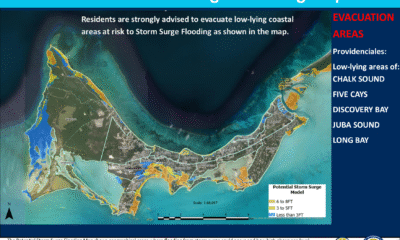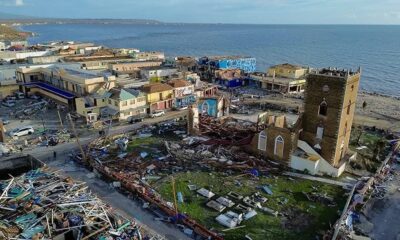Bahamas News
BAHAMAS: RBDF Strategy for addressing Human Smuggling in The Bahamas
Published
7 years agoon
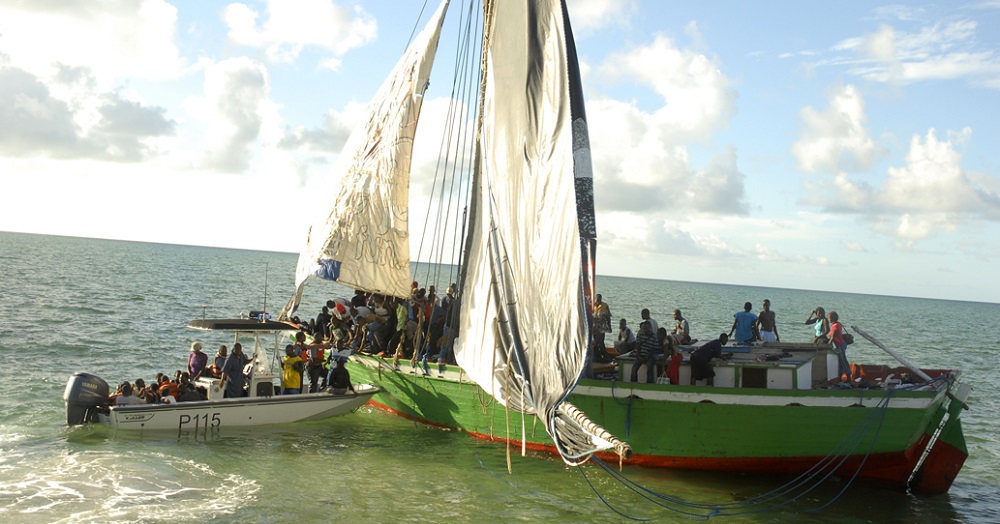
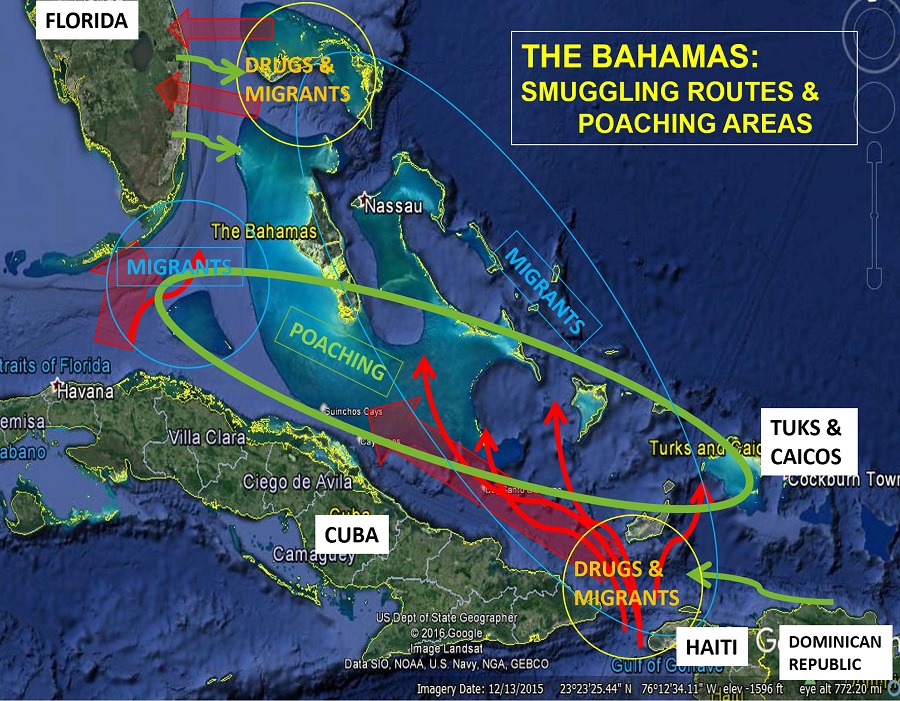
Coral Harbour Base, February 19, 2019 – Bahamas – The maritime borders of The Bahamas are challenged by illicit activities that often occur at the same time within different geographical locations around The Bahamas. To effectively respond to multiple threats including drug, human and weapons smuggling, as well as poaching and natural disasters, the Royal Bahamas Defence Force has been steadily unfolding a comprehensive program to decentralize its operations using a multi-layered security approach within a collaborative framework throughout our family of islands.
Short term maritime security measures alone will not work in solving challenges that confront The Bahamas in these changing times. Currently, most of the Defence Force patrol operations originate out of New Providence in the north-central Bahamas. The multi-pronged dentralization program in which the Defence Force is engaged calls for the establishment of bases for a sustained presence at strategic choke points throughout our islands.
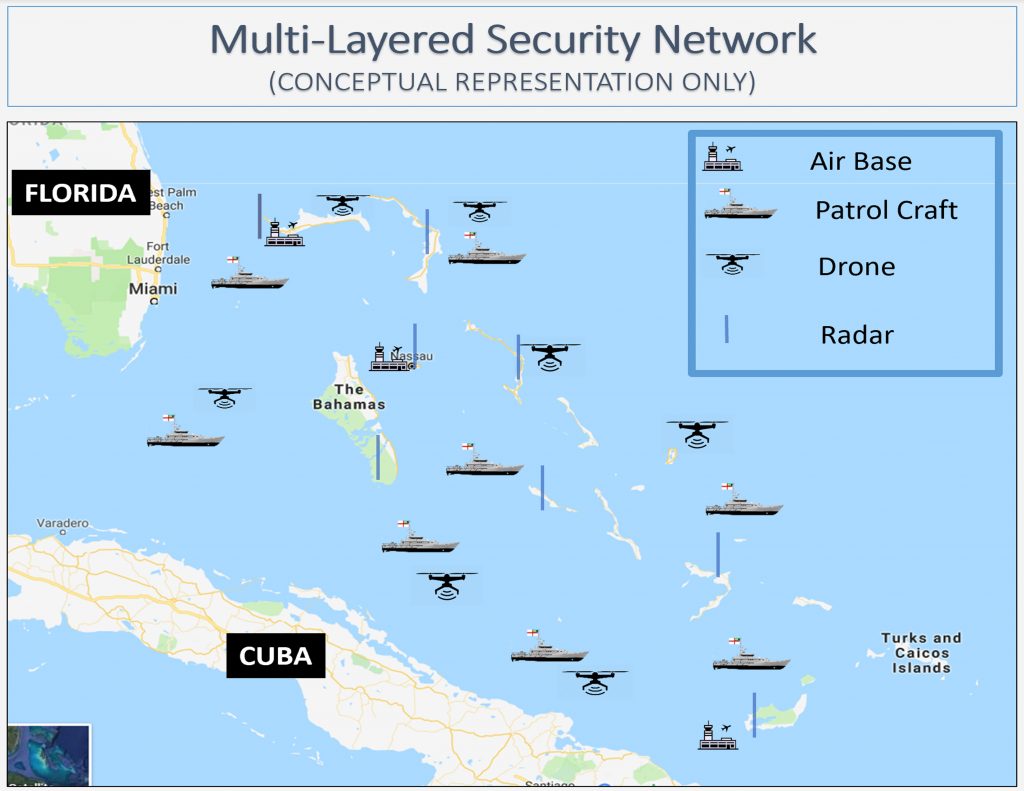
The program therefore involves the acquisition of ships, dredging of harbours, construction of quaywalls and jetties, expansion and/or construction of bases, the acquisition of detection and tracking technologies, and the strengthening of security cooperation with local and regional partners over the next five years.
In essence, decentralization’ is a long term, sustainable solution that facilitates the implementation of short term measures by the Defence Force in rolling back a diverse number of illicit activities. Additionally, this approach allows the Defence Force to provide necessary assistance to civilian authorities such as police, customs, immigration, the Department of Correctional Services, the National Emergency Management Agemcy and others.
PAST ACTIVITIES
Despite changes in the manner in which illicit activities are carried out on the maritime front, the Defence Force’s anti-migrant smuggling operations have unilaterally and in association with local and regional partners have apprehended almost 1,200 Haitian nationals last year. Also last year, approximately 200 Dominicans were apprehended by the Defence Force aboard 5 motherships resulting in the award of jail time and approximately $8 million dollars in fines by the courts.

The Defence Force had also deployed a number of its Marines to work with the Royal Bahamas Police Force in its crime reduction efforts on our streets throughout the year. The joint effort, which is still underway, yielded a noted reduction in the nation’s murder rate–the lowest in a decade. This collaboration also included two major operations in the Family Islands, resulting in arrests of persons wanted by Police or found in possession of weapons, drugs, and other contraband.
In addition to extensive disaster relief operations that were carried out at home and abroad (including an overseas mission to the Commonwealth of Dominica) during the period 2015 through 2017, Defence Force troops have provided fulltime security support for the residents of Ragged Island since that island was left devastated by Hurricane Irma in 2017.
CHANGING TRENDS AND PATTERNS
Smuggling of undocumented migrants is a major threat to The Bahamas. Needless to say, times and technologies have changed, so too have trends and patterns that are associated with the age-old problems of human, gun and drug smuggling, along with increased potential for terrorist-related activities. Weather patterns have also changed with an increase in frequency of tropical storms and hurricanes in the region.
In the case of smuggling of undocumented migrants, there have been noticeable changes with the type of vessels being used and the maritime routes taken by smugglers to enter The Bahamas. In addition to using traditional sailing sloops, smugglers are now using conventional sailing yachts, as well as motorized boats that make it more difficult to detect them. To improve their chances of evading authorities, smugglers are also networking with locals in the islands.
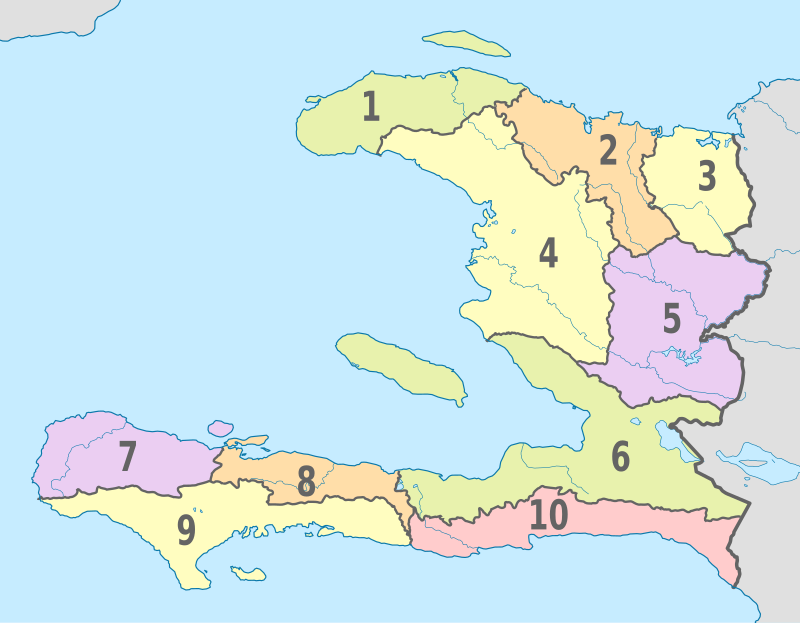
The thing that has not changed over many years is the improvement of border controls at the source country (the Republic of Haiti), which itself is challenged by a vast coastline and limited national resources to secure it. Thus, smugglers are able to operate freely at home, while placing more security demands on neighboring countries or territories such as The Bahamas and the Turks and Caicos Islands.
As the Defence Force makes headway in shutting down main smuggling routes, human smugglers naturally shift to new or alternative routes. With this balloon effect in play, common smuggling routes or access points now include the traditional northward passage, as well as additional maritime corridors in the southern Bahamas.
These access points exist from as far east as the Turks and Caicos Islands to as far west as Cay Lobos (on the ocean’s edge south of Andros Island). This southern gateway spans a distance of over 300 nautical miles (nm) making it possible for smugglers to by-pass Defence Force and US law enforcement assets operating in the south.
CLASSIC EXAMPLES
A classic example of how trends and patterns have changed over the years is seen in the matter involving the vessel that recently sank in waters off central Abaco on Saturday 2 February 2019. This tragic incident resulted in the loss of over 30 Haitian nationals. Their vessel struck a reef six miles off mainland Abaco and sank. It was not one of the traditional wooden sloops normally used for smuggling, but rather a modern 40-foot sailing yacht commonly used by hundreds of visitors to The Bahamas making it difficult for authorities to distinguish it as a human smuggling vessel. Additionally, the passage taken by this vessel could have very well been an irregular one off the eastern coast of our islands in the Atlantic Ocean.
Another example of changing trends is the influx of undocumented migrants being smuggled into the Turks and Caicos Islands. This British Overseas Territory at the southeastern end of The Bahama Island chain is extremely challenged by smugglers of Haitian nationals. With a tiny population of over 30,000 people, landings of undocumented migrants on these islands have been occurring more frequently with smugglers using traditional sloops, as well as motorized vessels with outboard engines.
Also, in January of this year, Cuban authorities intercepted a Haitian sloop with over 90 persons on board. This vessel was more than likely making its way westward along the Cuban coast with the hope of avoiding detection by Operation Bahamas Turks and Caicos (OPBAT) helicopters based in Inagua, US Coast Guard vessels patrolling the Windward Passage area near Haiti, and Defence Force patrol craft stationed in the south before heading northward anywhere along the extensive maritime boundary line between The Bahamas and Cuba.
OPERATION DECENTRALIZATION
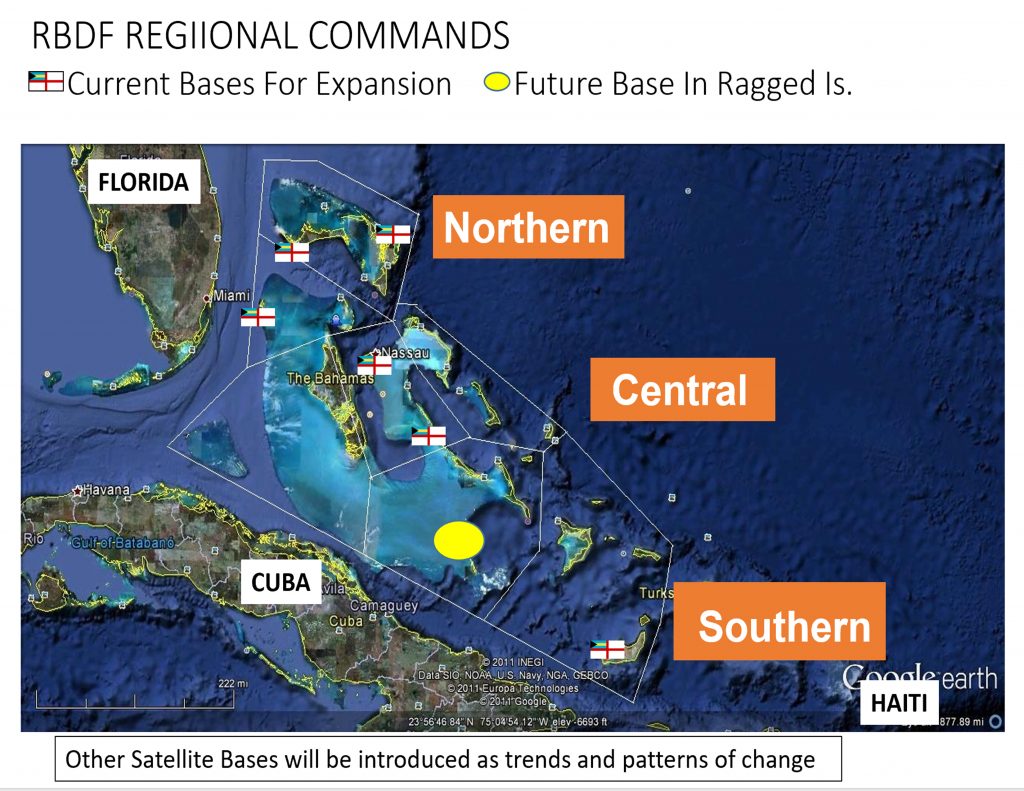
Although the Defence Force conducts patrols on short rotations in the southern Bahamas as part of its short term strategy, the organization is simultaneously unfolding its decentralization program through a multi-layered security approach with a collaborative approach for a sustaines and more effective effort. (
Presently, most Defence Force operations originate out of Coral Harbour Base in New Providence. Located in the north-central Bahamas, this base is over 300 nm from Inagua in the south and approximately 150 nm from the top of the Abaco chain in the north. New Providence-centric operations are time-consuming, ineffective and create much unnecessary wear and tear on ships and personnel for operations in the southern or northern Bahamas. The Defence Force’s decentralization program, therefore, requires the establishment of regional commands with fully operational bases at strategic locations in these areas over the next five years.
The decentralization program is designed to sustain the Defence Force’s presence at strategic locations throughout The Bahamas. The program will also reduce maintenance requirements on Defence Force ships and machinery, as well as limit undue stress on ships’ personnel when on 24/7 patrol assignments.
The nine ships that were acquired and the three major harbours yhat were dredged under the $232 million dollar Sandy Bottom Project during the period 2014 – 2017 constituted the first phase of the Defence Force’s decentralization program. The second and third phases of the decentralization program consists of the establishment of bases and the acquisition of detection and tracking technologies for the effective and efficient policing of Bahamian borders. These bases are needed to sustain the operations of ships and aircraft at strategic locations such as Inagua and Ragged Islands in the south, while detection technologies are instslled to enhance the efficiency of these operations.
A VAST MARITIME DOMAIN
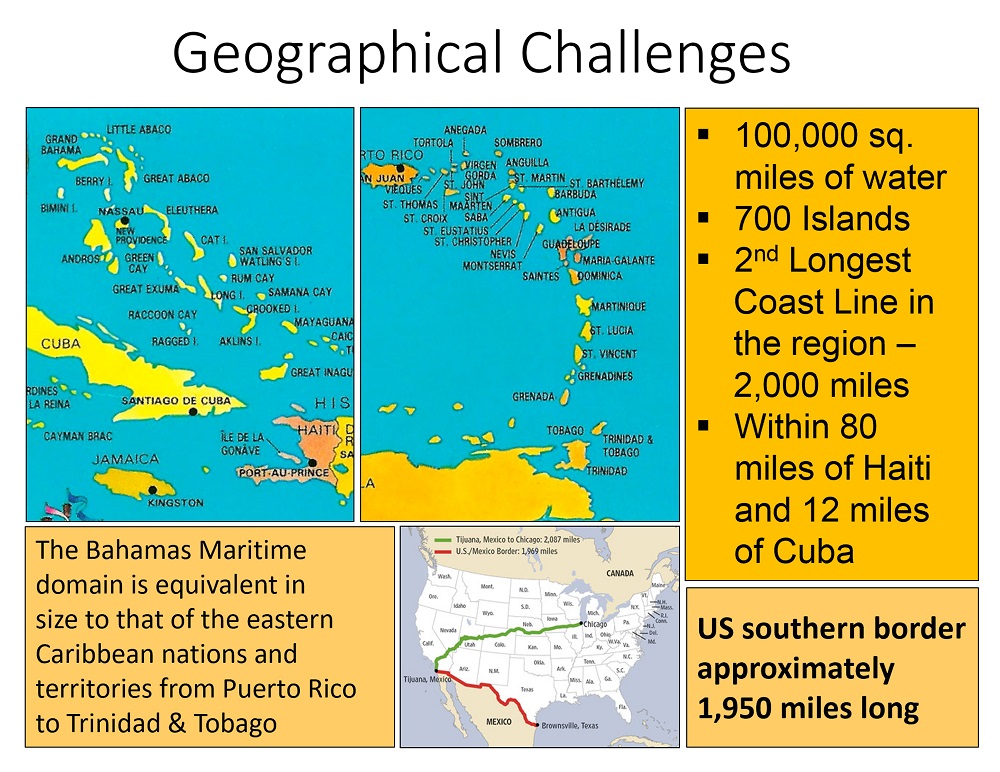
Unlike land patrols that have clearly defined boundaries with limited options for escape by criminals, the open sea has no limits. The vastness of The Bahamas maritime domain is severely underestimated by many. Take for example, how small the area just south of New Providence looks on a map. Often plied by Haitian sloops, this north-central area of the Great Bahama Bank is bounded by the Exuma Chain to the east, the Tongue of the Ocean to the west, and Green Cay near the southern end of the Tongue of the Ocean. In reality, this area alone covers over 9,000 square nautical miles of water. Compared to the 21-by-7-mile-wide New Providence Island where more than 70 percent of the nation’s population resides, this very small portion of the Great Bahama Bank is about 100 larger in size.
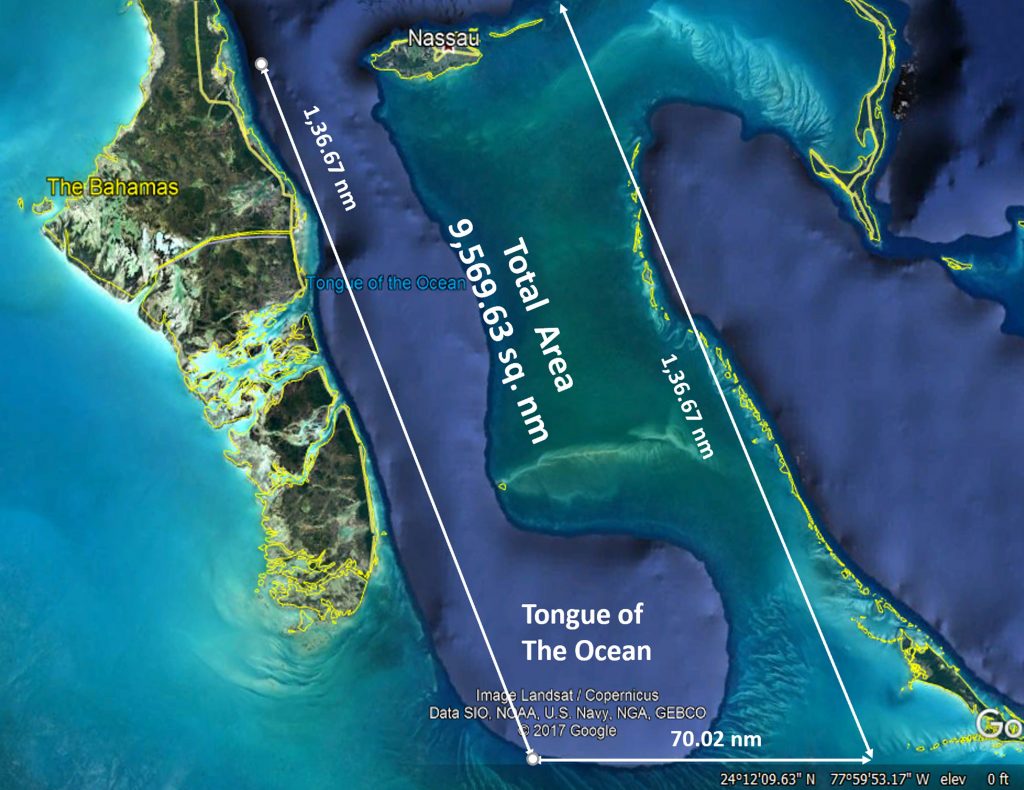
The average distance at which a low lying vessel, and in particular, a Haitian sloop can be seen on a clear day is approximately 3 to 7 miles with the naked eye during daylight hours. (Even regular marine radars are limited in detecting wooden Haitian sloops from a distance). In a very general sense, it would take several ships to maintain an effective watch over the 300 nm stretch of water between the Turks and Caicos Islands and Cay Lobos. Patrol effectiveness are all the more diminished during nighttime operations when smugglers travel most.
A recent example of the difficulty in detecting and tracking a human smuggling vessel is found when a patrol craft, a US Coast Guard Cutter, an OPBAT aircraft, and a police aircraft were deployed over several days to find a Haitian sloop that was initially sighted almost 200 nm southeast of New Provodence. In the end, the sloop was spotted by an OPBAT aircraft and intercepted by a Defence Force patrol craft on Sunday 16 February 2019 approximately 40 nm south of New Providence on the Great Bahama Bank.
The absence of adequate bases and patrol craft aided by appropriate detection and tracking technologies paints the picture of looking for a needle in the proverbial ‘haystack’ when searching for targets of interest. Without such technologies, more ships and personnel will be needed to keep a coastal watch on land and at sea with increased wear and tear on assets and personnel.
ACQUISITION OF REQUISITE TECHNOLOGIES
No single asset or detection equipment is going to solve today’s challenges. Each asset or equipment has its strengths and limitations; yet, their contributions are complementary to the success of effective border security. For example, the suspect vessel that a radar might fail to detect, might be located by a drone or an aircraft. The use of detection and tracking equipment is not a cure-all’; however, when used in a multi-layered approach, such technologies would enhance the chances of detecting and tracking illicit activities within The Bahamas’ maritime domain.
An effective decentralization program should therefore incorporate a multi-layered security approach consisting of ships, aircraft, radars, drones, Automated Identification Systems (AIS), Forward Looking Infra-Red Cameras, CCTVs, space satellites, and other detection equipment to enhance operational effectiveness.
Already, a coastal radar has been installed in Inagua inclusive of AIS equipment. It is the first in a series of coastal radars to be installed along our chain of islands with the financial support of the United States government. The US government has also funded a multi-million dollar communications equipment package that is being installed to improve Defence Force air, land and sea communications. Additionally, proposals have been received by the Ministry of Finance for the implementation of a multi-agency drone program that will consist of long and short-range drones to be managed by the Ministry of National Security.
INTERAGENCY AND REGIONAL COOPERATION

Furthermore, no single agency can roll back the tide of illicit activities. Interagency cooperation has been the mantra of the Minister of National Security, the Honourable Marvin Dames, ever since taking office in 2017. In further strengthening its resolve to prevent, monitor, detect, deter and/or apprehend those who violate our maritime laws, the RBDF continues to engage in collaborative efforts with its regional partners–the US, the Turks and Caicos Islands, the Republic of Cuba, and Jamaica–in the areas of information sharing and security cooperation with favourable results. The Defence Force also looks forward to engaging in security cooperation dialogue with its counterparts in the Republic of Haiti and the Dominican Republic through the office of the Ministry of Foreign Affairs.
THE WAY AHEAD
Undoubtedly, the way ahead requires significant investment, which is being addressed. In view of multiple maritime challenges confronting The Bahamas, the Defence Force is shifting from a reactionary approach towards the phased implementation of its decentralization program for the effective policing of borders of The Bahamas.
In the interim, the dedicated, hard-working men and women of the Defence Force will continue to adjust and adapt their mode of operating to overcome human smuggling and other illegal activities in collaboration with local and regiomal partners while the goal of decentralization is being realized.
(For further information please contact the RBDF Public Relations Department or visit our website: www.rbdf.gov.bs, follow us on Facebook, Twitter and view our Youtube channel)
-rbdf-
#GuardOurHeritage
#MarlinSpike
Press Release: RBDF
You may like
Bahamas News
Walker Confirmed as U.S. Ambassador to The Bahamas: A Partner in America’s Extended Family
Published
3 weeks agoon
October 14, 2025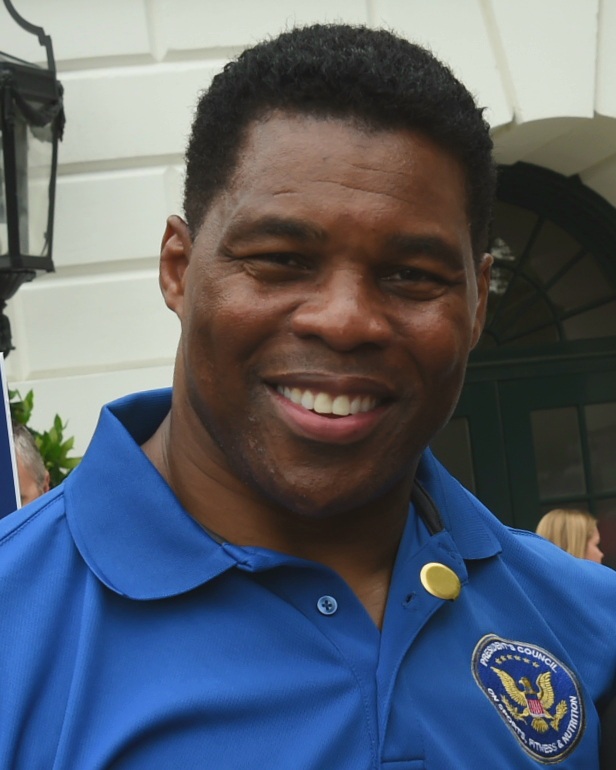
By Deandrea Hamilton | Magnetic Media
The United States and The Bahamas share more than proximity — they share a bond of history, trade, and culture that Washington’s newest diplomat calls “part of America’s extended community.”
Now, for the first time in 14 years, the U.S. Embassy in Nassau will again be led by a Senate-confirmed ambassador. Herschel Walker, the Heisman-winning football legend turned entrepreneur, has been confirmed by the U.S. Senate as America’s official envoy to The Bahamas.
Walker, who will oversee one of the Caribbean’s most strategically positioned U.S. missions, told senators during his confirmation hearing that The Bahamas will play a key role in upcoming U.S. 250th Independence celebrations. “The Bahamian people,” he said, “will be included in this milestone year, because our stories are intertwined — through family, trade, and friendship.”
While his nomination was unconventional, his priorities are anything but vague. Walker vowed to counter growing Chinese influence in the Caribbean, calling Beijing’s investments in Bahamian deep-water ports “a direct threat to U.S. national security.” He pledged to work closely with Bahamian authorities to ensure American interests remain the region’s cornerstone.
“There’s a rise in drug smuggling in The Bahamas, and this is a real danger to the United States,” Walker said, referring to the Operation Bahamas, Turks and Caicos (OPBAT) partnership. He promised to strengthen intelligence sharing, joint patrols, and law enforcement coordination to disrupt trafficking routes that have grown increasingly sophisticated.
But Walker also emphasized opportunity over fear — signaling that his ambassadorship will not only focus on security, but on strengthening The Bahamas as a gateway for U.S. investment, trade, and tourism.
“I will advise the American business community of the vast investment opportunities that exist in The Bahamas,” he said. “And I will make sure the Bahamian government maintains an environment where U.S. companies can invest confidently — because America must prove it is still great as an investor.”
For a small island nation sitting less than 50 miles off the coast of Florida, this renewed diplomatic attention carries weight. Since 2011, the post of U.S. ambassador had remained vacant — a gap that many observers say weakened direct ties, delayed joint security initiatives, and allowed other powers to move in.
Walker’s confirmation — approved 51 to 47 — ends that silence. And with it comes the expectation that this former Olympian and business owner will translate his discipline, charisma, and resilience into diplomatic results.
Critics question his lack of foreign policy experience, but Walker counters with confidence: “Throughout my life, people have underestimated me. I’ve always proved them wrong — by outworking everyone.”
As he prepares to take up residence in Nassau, Walker says his mission is simple: rebuild trust, deepen cooperation, and remind both nations that their futures are tied not just by geography — but by shared purpose, mutual respect, and the enduring ties of community.
Angle by Deandrea Hamilton. Built with ChatGPT (AI). Magnetic Media — CAPTURING LIFE.
Bahamas News
PAY STANDOFF: Prime Minister Cancels Talks as Unions Warn of More Protests
Published
3 weeks agoon
October 13, 2025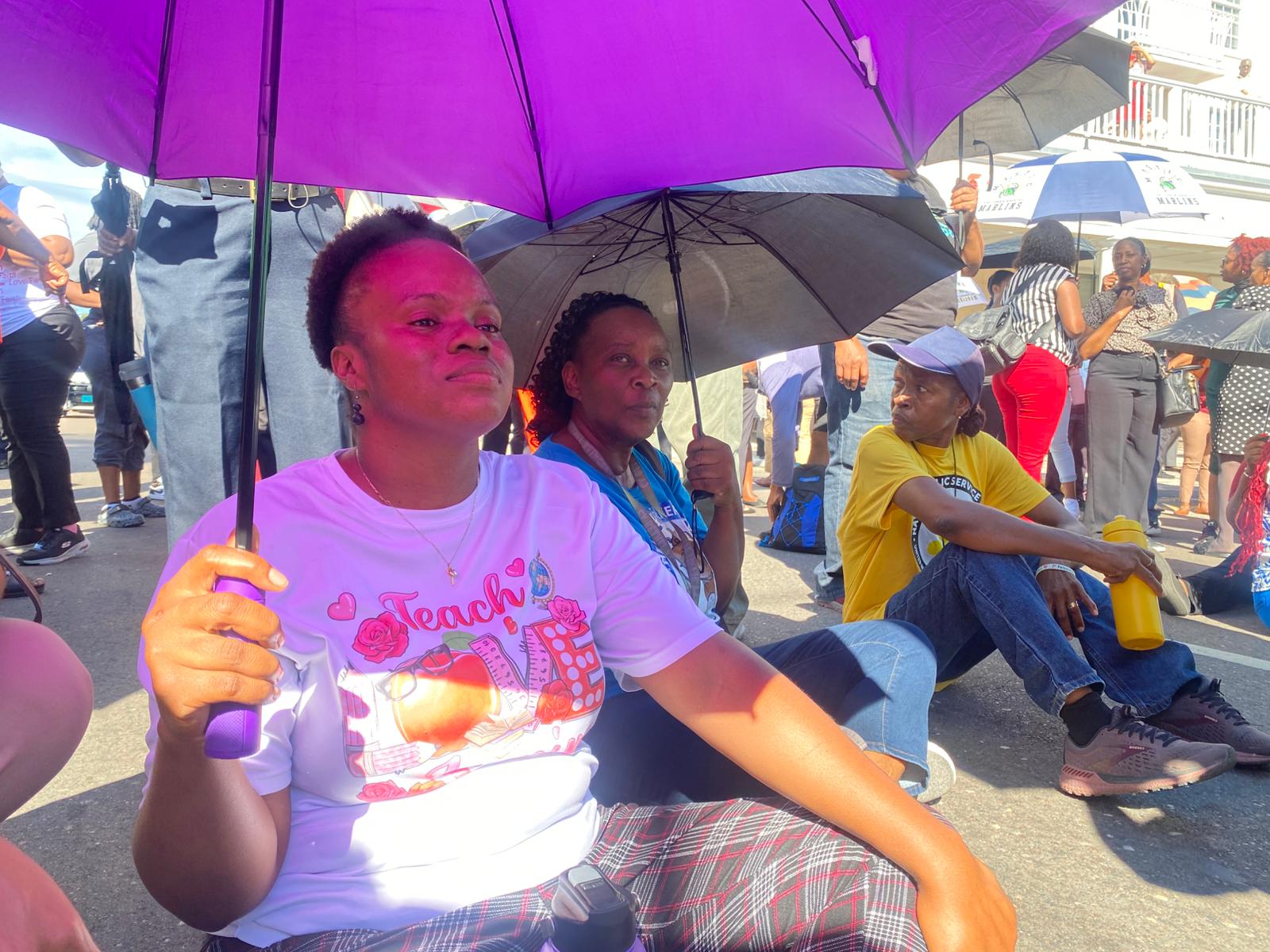
By Deandrea Hamilton | Magnetic Media
Monday, October 13, 2025 — Nassau, The Bahamas – What began as a calm holiday meeting has spiraled into a full-blown standoff between The Bahamas Government and two of the country’s most powerful public sector unions — the Bahamas Union of Teachers (BUT) and the Bahamas Public Services Union (BPSU) — after the Prime Minister abruptly cancelled follow-up talks set for Tuesday, blaming public comments made by union leaders.
The announcement of the cancelled meeting came late Monday, just hours after a tense sit-down at the Office of the Prime Minister, held on National Heroes Day, where both BUT President Belinda Wilson and BPSU President Kimsley Ferguson accused the government of dragging its feet on salary increases and retroactive pay owed to thousands of public officers.
Wilson, never one to mince words, said the Prime Minister’s “technical officers” — the very people responsible for executing his instructions — were failing to carry out his directives regarding payment timelines.
“The Prime Minister’s issue,” Wilson said, “is that he has persons working for him who are not following his instructions. If those officers would follow through on what he told them to do, we wouldn’t be here today.”
Wilson added that the BUT and other unions are demanding retroactive pay dating back to September 2024, and that all increases be applied and paid by the October payday, not December as previously stated by the Prime Minister.
“Senior civil servants already received their retroactive pay — thousands of dollars — backdated to September of last year,” Wilson charged. “We’re saying the small man deserves the same. This isn’t a gift. It’s money already earned.”
Her comments came after the government publicly insisted that the salary adjustments would be implemented by December 2025, just ahead of Christmas — a timeline unions flatly reject as too slow.
Ferguson: ‘No More Excuses’
Following Wilson, BPSU President Kimsley Ferguson delivered a fiery statement of his own, telling reporters the unions would no longer tolerate delays or mixed messages from the Davis administration.
“The Prime Minister was receptive — but we’re not accepting excuses,” Ferguson said. “If the Prime Minister’s having a memory lapse, we have the Hansard from Parliament to remind him exactly what he promised public officers.”
Ferguson went further, warning that if Tuesday’s meeting failed to produce results, unions would “visit the House of Assembly” and intensify their campaign for immediate payment.
“Public servants, ready yourselves,” he declared. “We are prepared to stand together — all across The Bahamas — until our needs are met.”
Now, with the Prime Minister cancelling tomorrow’s talks altogether, that threat appears closer to becoming reality.
Government Bungles Response
Observers say the administration’s handling of the matter has been confused and contradictory, with conflicting statements on payment timelines and poor communication fueling frustration among teachers, nurses, and general public officers.
The government has maintained that the funds are allocated and will be disbursed before year’s end, but unionists insist they’ve heard it all before — and this time they want results, not promises.
The Prime Minister’s decision to cancel the meeting, rather than clarify or de-escalate tensions, has drawn sharp criticism across social media and among rank-and-file civil servants who see the move as punitive and dismissive.
Slowdown and the Threat of Another Mass Protest
Across several ministries, departments, and schools, reports are already surfacing of a go-slow in the public service, as workers express solidarity with the unions’ demands.
Many believe another mass demonstration is imminent, similar to the one staged last week Tuesday when thousands of workers gathered outside the House of Assembly on Bay Street as Parliament reopened after summer recess.
That protest brought parts of downtown Nassau to a standstill as union members sang, marched, and even sat in the street — a powerful show of defiance that now threatens to repeat itself unless the government moves quickly to resolve the impasse.
A Political Flashpoint
What began as a straightforward salary dispute has now evolved into a test of credibility and competence for the Davis administration. With a restless public sector, rising inflation, and unions unified across professions, the government risks not only another protest — but a full-blown industrial crisis heading into the year’s end.
For now, the unions are standing firm: they want retroactive pay from September 2024 and full salary adjustments by this October. Anything less, they warn, could push the country’s workforce from a slowdown into open confrontation.
Angle by Deandrea Hamilton. Built with ChatGPT (AI). Magnetic Media — CAPTURING LIFE.
Bahamas News
Nassau Cruise Port Marks Sixth Anniversary with Exciting New Additions for Visitors and The community
Published
4 weeks agoon
October 8, 2025
[Nassau, Bahamas, October 8, 2025] Nassau Cruise Port (NCP) proudly celebrates its sixth corporate anniversary by unveiling a series of transformative additions that further enhance the guest and community experience. The anniversary comes at a pivotal moment in the growth of the port, with the opening of a new swimming pool, an expanded marina, and a state-of-the-art ferry terminal that will support transfers to the Royal Beach Club, which is currently under construction on Paradise Island.
Since its $300 million redevelopment, Nassau Cruise Port – the largest transit cruise port in the world – has welcomed millions of visitors and become one of the most vibrant cruise destinations in the world. This anniversary not only reflects its commitment to delivering world-class facilities, but also its dedication to creating meaningful connections between visitors and the Bahamian community.
“This milestone represents much more than the passage of time,” said Mike Maura, Jr., CEO and Director of Nassau Cruise Port. “It reflects our promise to continually elevate the guest experience, contribute to the local economy, and provide opportunities for Bahamians. During our first year (2019) of operating the Nassau Cruise Port, Nassau welcomed approximately. 3.85 million cruise guests, and 2025 will see well over 6 million cruise visitors visit Nassau. Our focus on driving cruise tourism and the $350 million investment in our downtown waterfront is a testament to our vision of making Nassau a premier cruise and leisure destination.”
The new pool offers a refreshing retreat for visitors enjoying Nassau’s waterfront, while the expanded marina will accommodate additional yachts, boosting tourism and local commerce. The ferry terminal expansion enhances passenger flow and supports convenient, seamless transfers to the Royal Beach Club, strengthening Nassau’s position as a hub for Caribbean cruising and leisure.
As part of its anniversary celebrations, NCP will host a series of internal and external activities to celebrate its team and to highlight its ongoing investments in the Bahamian economy, including job creation, local vendor opportunities, and cultural showcases at the port.






